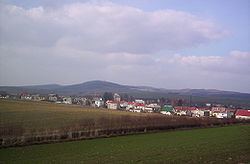Town rights 1962 Population 6,747 (2008) | Area 20.93 km² Local time Tuesday 4:24 AM | |
 | ||
Gmina Piława Górna (urban gmina) Weather 9°C, Wind W at 23 km/h, 71% Humidity Voivodeship | ||
Piława Górna [pʲiˈwava ˈɡurna] (German: Ober-Peilau or Gnadenfrei) is a town in Dzierżoniów County, Lower Silesian Voivodeship, in south-western Poland, in the western part of the Wzgórza Strzelińskie hills. Prior to 1945 it was in Germany. It lies approximately 15 kilometres (9 mi) east of Dzierżoniów, and 54 kilometres (34 mi) south of the regional capital Wrocław.
Contents
Map of Pi%C5%82awa G%C3%B3rna, Poland
According to official figures for 2008, the town has a population of 6,747.
From 1975 to 1998 Piława Górna was in Wałbrzych Voivodeship.
History
Piława Górna was founded by the 16th century at the latest as an agricultural village in Lower Silesia. After its annexation by the Kingdom of Prussia from Austria in the First Silesian War, German settlers developed a clothing industry in the village in 1743. A settlement congregation of the Moravian Brethren was built in Upper Peilau, i.e. Piława Górna, on the estate of the Austrian noble Ernst Julius, Count von Seydlitz. Imprisoned for his Protestant faith by the Habsburg rulers of Silesia, when he was freed following the Prussian seizure of Silesia, he named the new settlement "Gnadenfrei" ("freed by [God's] Grace") to commemorate the event. Peilau/Piława was for many years "the longest village in Germany", stretching for several miles along the Piława/Peila stream.
By the beginning of the 20th century the village was almost completely German in ethnicity and Protestant in confession. In 1945 after World War II, it was transferred from Germany to Poland. Its German population was expelled and replaced with Roman Catholic Poles, themselves having been expelled from the Lwów (Lviv) region (now in Ukraine).
In 1962 Piława Górna was granted town privileges. Architectural sights include a church (built from the 16th-19th centuries) and an 18th-century palace.
Economy
Weaving mills and quarries were located in the vicinity of Piława Górna by the 14th century; the former state textile firm and quarry still exists in the town. In 2002 Piława Górna had 120 stone-working businesses, 27 textile businesses of various kinds, 172 trade companies, and 157 service industries. The agricultural industry is based on local farming and consists of 115 small businesses which mostly grow sugar beets, rapeseed, and grains.
In order to promote tourism in the region, Piława Górna engages in agritourism.
